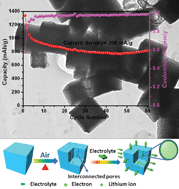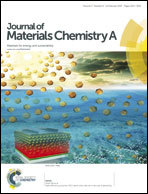Metal–organic framework-derived porous Mn1.8Fe1.2O4 nanocubes with an interconnected channel structure as high-performance anodes for lithium ion batteries†
Abstract
A facile two-step strategy involving a room-temperature synthesis and subsequent thermal calcination of a binary-metal-based metal–organic framework (MOF) has been successfully developed for the preparation of porous Mn1.8Fe1.2O4 nanocubes. The as-prepared Mn1.8Fe1.2O4 inherits the morphologies of MOFs and shows a porous structure with a relatively high specific surface area (124 m2 g−1) due to the release of small gas molecules (CO2 and NO2) in the calcination process in air. The as-prepared porous Mn1.8Fe1.2O4 nanocubes exhibit greatly enhanced performance for Li storage. The capacity of the porous Mn1.8Fe1.2O4 retained 827 mA h g−1 after 60 cycles at a current density of 200 mA g−1. The enhanced electrochemical performance is attributed to the interconnected porous structures and large amount of mesopores, which effectively improve structural stability, reduce the diffusion length for lithium ions and electrons, and buffer volume expansion during the Li+ insertion/extraction processes. These results indicate that the as-prepared porous Mn1.8Fe1.2O4 nanocubes can be promising anode materials for high-performance LIBs.

- This article is part of the themed collection: 2015 Journal of Materials Chemistry A Hot Papers

 Please wait while we load your content...
Please wait while we load your content...